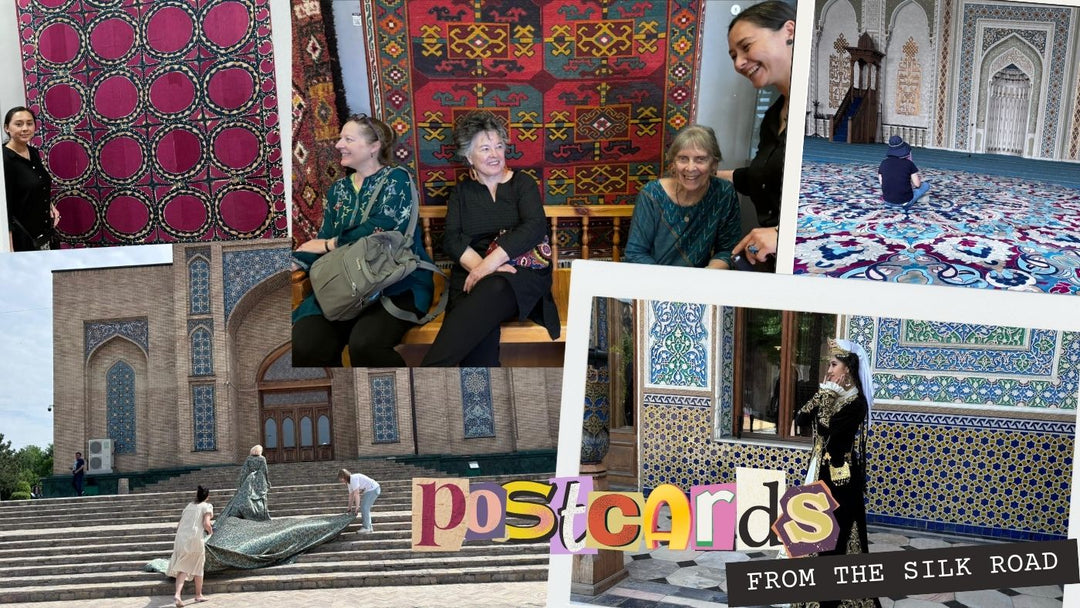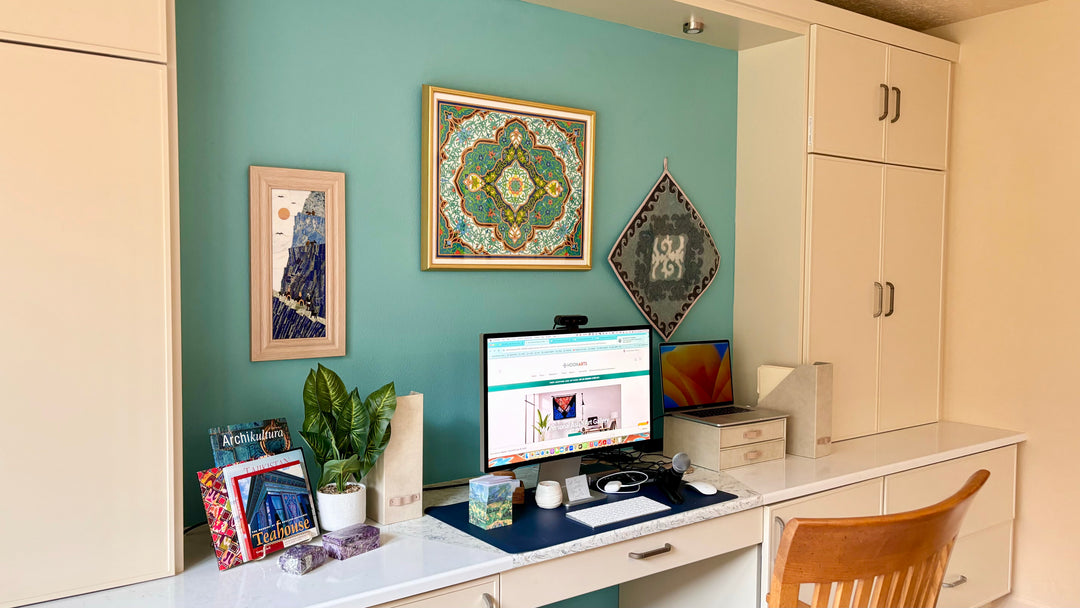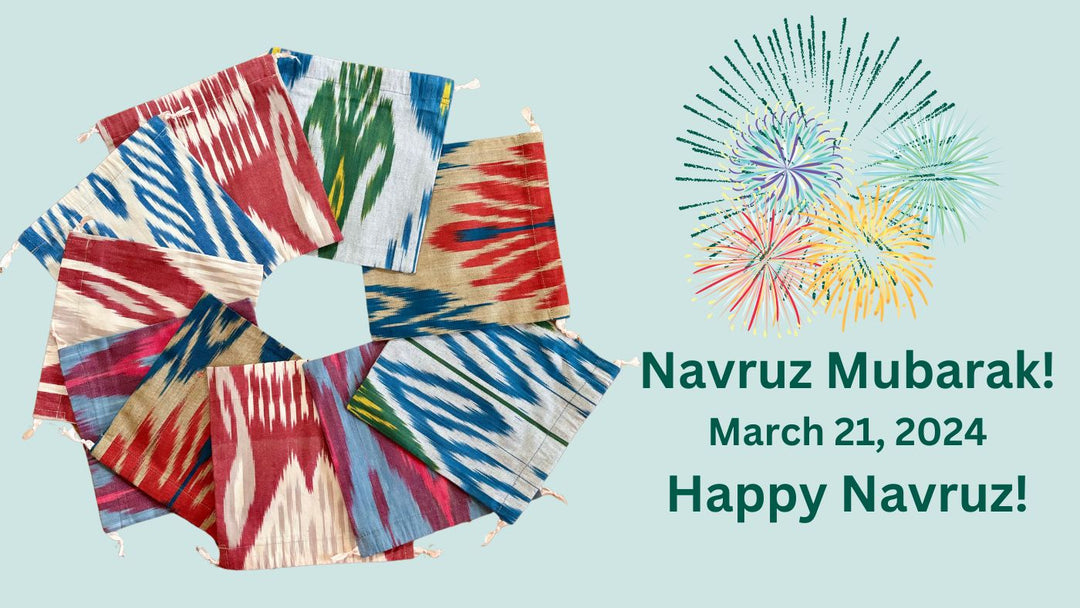Central Asia has a long and rich history of textile traditions, including weaving, dyeing, embroidery, carpet making, patchwork and more. These textiles traveled the Silk Road in both directions for hundreds of years.
One of the textile arts associated with the region that has gained popularity in the West in recent years is the world of "ikats." The term "ikat" is now typically understood in the West to refer to the dramatic and slightly blurred patterns inspired by the traditional colorful Central Asian handwoven silk fabrics. Thus, a Google search for the term "ikat" will typically turn up mass produced fashion and home decor products, often made from printed fabrics manufactured in large Chinese factories.
The authentic Central Asian "ikat", however, is hand dyed and hand-woven, using a laborious 37 step process. And it also comes with its own unique vocabulary.
In this article, I wanted to share some of the most common (and commonly misunderstood) terms used in connection with the handwoven ikats produced in Margilan, Uzbekistan. As I learned from my artisan manager in next-door Tajikistan, even other textile experts in the region get the terms confused!
IKAT
"Ikat" is actually an Indonesian word (from "to bind"). Although used generically in the West to refer to the characteristic pattern, "ikat" actually refers to the resist-dyeing and weaving process in which the threads are dyed (and patterns created) before weaving.
The ikat weaving technique evolved independently (and often simultaneously) around the world, so you will find hand-dyed ikats in Japan and Guatemala as well as Central Asia. The term "ikat" is not actually used in Central Asia, except when talking to international visitors. The Central Asian generic term is "abrband" ("tying a cloud”). Margilan, Uzbekistan is the center of ikat weaving in Central Asia, though a few old masters have begun reviving ikat weaving with cotton in Tajikistan.
In ikat the resist is formed by binding individual threads or bundles of threads with a tight wrapping applied in the desired pattern. Once bound to create patterns, the threads are then dyed, by hand. The bound parts of the thread do not take on the dye color, whereas the unbound, exposed parts are colored. The tightly bound areas are waxed before dyeing so that the dye does not penetrate when the bundles are soaked in the dye. To create new patterns, the bindings may then be altered and the threads dyed again with another color. This process may be repeated multiple times to produce elaborate, multicolored patterns. When the dyeing is finished, all the bindings are removed and the threads are woven into cloth.

Resist Dyeing the Threads with Wrapping
ADRAS
"Adras" is the most common hand-woven ikat from Central Asia, made with a silk- cotton blend of threads, typically around 50% each. Adras is a "plain weave", 2 pedal fabric which produces the same pattern on both sides. (The same loom is used for weaving all ikat fabrics, and the warping process is the same for all. The final weaving process and use of pedals distinguishes the different types and textures.)
Adras was the most popular fabric in the 18th and 19th centuries and was used for chapans (traditional long coats), dresses and many everyday products. While forgotten during the Soviet era, its revival began around 2002 in Uzbekistan. In adras designs mostly floral patterns are used. There are certain designs with animal names like "Chayon" (scorpion), "Toshbaqa" (turtle) or jewelry "Kashghar baldoq" (kashghar earring), "Tumor" (talisman) and so on. Because of the inclusion of cotton, adras has a heavier, slightly stiffer texture. It is ideal for scarves, clothing, accessories and home decor products.

Adras scarf from Craft Studio IkatUz.
ATLAS
"Atlas" is the satin weave ikat, which uses an eight pedal weaving process. In atlas, the ikat pattern is all on the front/right side of the fabric and has a glossy, shiny finish. The back/wrong side is a solid color, as the weft threads all go to the back of the fabric. The satin weave technique produces a heavier texture than plain weave. Atlas can be all silk or combined with cotton or viscose. If viscose or cotton is used for the weft, then the price will be the same as adras.
The price of ikats today is largely dependent upon the amount of silk used for the warp and weft, the complexity of the design and whether the dyes used are chemical or natural.
"Atlas" was considered the more luxurious fabric in the 18th and 19th centuries, and it was mostly used as gift fabric for ambassadors. From the 1960's, it became more popular and began being used for women's dresses, blankets, and mats.
New designs of "Atlas" were created in Margilan and it was called "Khan Atlas" - translated as "king atlas". During the Soviet era, the weavers created special new designs like "Kremlin", "Olympiad-80" and patterns with geometric motifs.

Atlas weave-shiny on front side, solid on reverse side.
SHOYI (UZBEK) OR SHOHI (TAJIK)
"Shoyi" is the Uzbek term for 100% hand-woven silk ikat. It has a lighter, more flexible texture than either atlas or adras, and is ideal for scarves. A popular variation of the shoyi scarf is to "tea wash" the fabric after weaving, to produce a slight tea coloration.

All silk ("shoyi" or "shohi") ikat scarf.
BAKHMAL
Ikat velvet, called baghmal or bakhmal in Uzbek, demands more: more silk, more time, more preparation, more skill, more patience. Its rich cut-pile surface is a field of tiny tufts made from individual pile warp units. These piles change color along their lengths adhering to a plan: when woven, the design emerges. The velvet structure requires many adjustments to the standard processes.
Velvet needs two sets of warps, а pile and а ground. And the warp is always silk. For a softer fabric, silk is also used for the weft. For a stiffer, heavier weight fabric, cotton is used for the weft.
The weaver raises the pile warps over а slim, round wire, and secures it by three grounds before inserting the next wire. On the second ground the pile warp is also interlaced. Once several wires are woven in, the first wires can be safely cut out, by hand.

Weaving velvet ikat with double silk warp.

Carefully cutting the pile warp by hand.
ISKAT
All Uzbek ikats are produced with repeating patterns of varying lengths. At the beginning and end of each repeating pattern, you will see a clear line across the width of the pattern, called the "iskat." You can see this line in the pink and white fabric being woven in the top photo, with a close-up of the iskat in the photo below.
Many people think this line is a flaw in the fabric. Far from being a flaw, the iskat is an integral part of the weaving process, which helps the weaver line up the pattern as the loom is threaded. Remember, the threads are dyed (and the pattern created) before the loom is threaded and the fabric is woven. If the dyed threads are not lined up just right, then the pattern simply doesn't work.

The pattern repeat line or "iskat".
I hope this little mini-lesson in some of the key vocabulary of ikats gives you a taste of the rich complexity of the authentic Central Asian ikat.
If you missed our little "unboxing" video about the latest ikat scarves we just received from Craft Studio IkatUz, just click the photo below to see all the gorgeous colors and patterns. Each scarf is $49.95 plus $8 for shipping. They haven't been uploaded to our online store yet, so just email or DM me if one of them catches your eye and I'll get it to you.
COMING LATER THIS WEEK: VIDEOS DEMONSTRATING IKAT PRODUCTION
If you're curious about the actual dyeing and weaving process, later this week I'll be posting a couple of short videos produced and shared by our artisans at Craft Studio IkatUz in Margilan, Uzbekistan. Stay tuned!








Leave a comment